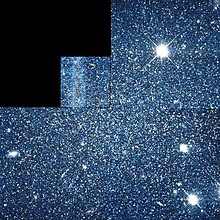Pegasus dwarf galaxy
Two different dwarf galaxies at the edge of the local group are referred to as the Pegasus dwarf galaxy .
Peg dSph
The spheroid Pegasus dwarf galaxy (also Peg dSph , for Pegasus Dwarf Spheroidal Galaxy ) is also known as Pegasus II, Andromeda VI or KKH 99. It is a dwarf spheroid galaxy (subtype of the elliptical dwarf galaxies) of the type dSph or dE3, which belongs to the Andromeda galaxy . It is about 2.5 million light years from Earth ( Milky Way ) and about 6,000 light years across.
The galaxy was discovered in 1998 on images from the Palomar sky survey POSS-II .
Peg dig
The Irregular Pegasus Dwarf Galaxy (also Peg DIG , for Pegasus Dwarf Irregular Galaxy ) is also known as UGC 12613, DDO 216 or A2304. As an irregular galaxy, it is an irregularly shaped dwarf galaxy and, like its namesake Peg dSph, a satellite of the Andromeda Galaxy and is located about 3.3 million light years from Earth.
Peg DIG was discovered by Albert George Wilson in the 1950s .
Trivia
The Pegasus Galaxy is mentioned in the science fiction series Stargate as the last home of the ancients, which is the most advanced species in the Stargate universe. The lost ancient city of Atlantis is also located there.
Individual evidence
- ↑ Karachentseva, VE; Karachentsev, ID: A list of new nearby dwarf galaxy candidates . In: Astronomy and Astrophysics Supplement . tape 127 , 1998, pp. 409-419 , bibcode : 1998A & AS..127..409K .

